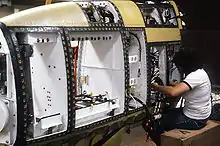AN/ALQ-99
The AN/ALQ-99 is an airborne electronic warfare system, found on EA-6B and EA-18G military aircraft. The ALQ-99E version of the system was carried on the EF-111A Raven aircraft as an escort or standoff jammer.

Description
The ALQ-99 is an airborne integrated jamming system designed and manufactured by EDO Corporation. Receiver equipment and antennas are mounted in a fin-tip pod while jamming transmitters and exciter equipment are located in under-wing pods. The system is capable of intercepting, automatically processing and jamming received radio frequency signals.[1] The system receivers can also be used to detect, identify and direction find those signals, providing signals intelligence (SIGINT) either automatically or manually.[2]

The AN/ALQ-99 is mounted on the U.S. Navy's and U.S. Marine Corps EA-6B Prowler aircraft and U.S. Navy's EA-18G Growler aircraft. It was mounted on U.S. Air Force's EF-111A Raven aircraft before these aircraft were retired from service by May 1998. The U.S. Navy's EA-6B Prowler were Retired from Active service following deployment in 2015.
The AN/ALQ-99 has a maximum power output of 10.8 kW in its older versions and of 6.8 kW in its newer versions.[3] It uses a ram air turbine to supply its own power.
History

The AN/ALQ-99 has been used during the Vietnam War (1972–1973), Operation El Dorado Canyon (1986 American raid in Libya), 1991 Gulf War, Operation Northern Watch (1992–2003), Operation Southern Watch (1997–2003), 1999 Balkans War, 2003 Second Gulf War, and 2011 Operation Odyssey Dawn. The poor reliability of the ALQ-99 and frequent failures of the Built-In Test (BIT) have caused crew to fly missions with undetected faults; the ALQ-99 also interferes with the aircraft's AESA radar, reduces the top speed of the aircraft and imposes a high workload on the two man crew when employed in the EA-18G Growler.[4]
Versions
- AN/ALQ-99E – the version mounted on EF-111A aircraft. It has a 70% commonality with the U.S. Navy's AN/ALQ-99 systems.
See also
- CAMPS Civil Aircraft Missile Protection System
- Electronic warfare
- Electronic countermeasures
- EA-6B Prowler
- EA-18G Growler
- Next Generation Jammer
Related ECMs
References
- EDO Corporation EA-6B Page Archived 17 October 2006 at the Wayback Machine.
- The Warfighter's encyclopedia Archived 12 August 2006 at the Wayback Machine. EA-6B Prowler Archived 5 November 2004 at the Wayback Machine.
- Cooling Requirements for the Advanced Ram Air Driven Power and Cooling Unit (ARADPCU) on the EA-18G Archived 29 June 2011 at the Wayback Machine.
- "GAO-10-388SP, Defense Acquisitions: Assessments of Selected Weapon Programs, March 30, 2010". Retrieved 15 February 2012.
External links
| Wikimedia Commons has media related to AN/ALQ-99. |
- The Anatomy of the Tacjammer
- Advanced Ram Air Driven Power and Cooling Unit (for ALQ-99 and nextgen equipment)
- EDO Corp – Manufacturer of components of the ALQ-99 system
- Harris Corporation acquired EDO in 2016